The vaccinia virus-encoded Bcl-2 homologues do not act as direct Bax inhibitors
- PMID: 22013032
- PMCID: PMC3255923
- DOI: 10.1128/JVI.05817-11
The vaccinia virus-encoded Bcl-2 homologues do not act as direct Bax inhibitors
Abstract
Many viruses, including members of several poxvirus genera, encode inhibitors that block apoptosis by simultaneously binding the proapoptotic Bcl-2 proteins Bak and Bax. The Orthopoxvirus vaccinia virus encodes the Bcl-2-like F1 protein, which sequesters Bak but not Bax. However, N1, a potent virulence factor, is reported to be antiapoptotic and to interact with Bax. Here we investigated whether vaccinia virus inhibits Bak/Bax-dependent apoptosis via the cooperative action of F1 and N1. We found that Western Reserve (WR) and ΔN1L viruses inhibited drug- and infection-induced apoptosis equally. Meanwhile, infections with ΔF1L or ΔN1L/F1L virus resulted in similar levels of Bax activation and apoptosis. Outside the context of infection, N1 did not block drug- or Bax-induced cell death or interact with Bax. In addition to F1 and N1, vaccinia virus encodes further structural homologs of Bcl-2 proteins that are conserved in orthopoxviruses, including A46, A52, B14, C1, C6, C16/B22, K7, and N2. However, we found that these do not associate with Bax or inhibit drug-induced cell death. Based on our findings that N1 is not an antiapoptotic protein, we propose that the F1 orthologs represent the only orthopoxvirus Bcl-2 homolog to directly inhibit the Bak/Bax checkpoint.
Figures
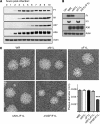
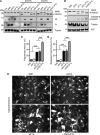
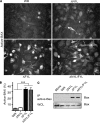
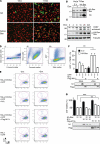


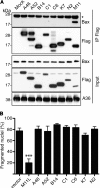
Similar articles
-
Structural insight into BH3 domain binding of vaccinia virus antiapoptotic F1L.J Virol. 2014 Aug;88(15):8667-77. doi: 10.1128/JVI.01092-14. Epub 2014 May 21. J Virol. 2014. PMID: 24850748 Free PMC article.
-
Vaccinia virus F1L interacts with Bak using highly divergent Bcl-2 homology domains and replaces the function of Mcl-1.J Biol Chem. 2010 Feb 12;285(7):4695-708. doi: 10.1074/jbc.M109.053769. Epub 2009 Dec 2. J Biol Chem. 2010. PMID: 19955184 Free PMC article.
-
The vaccinia virus protein F1L interacts with Bim and inhibits activation of the pro-apoptotic protein Bax.J Biol Chem. 2006 Dec 22;281(51):39728-39. doi: 10.1074/jbc.M607465200. Epub 2006 Oct 30. J Biol Chem. 2006. PMID: 17074758
-
The fowlpox virus BCL-2 homologue, FPV039, interacts with activated Bax and a discrete subset of BH3-only proteins to inhibit apoptosis.J Virol. 2009 Jul;83(14):7085-98. doi: 10.1128/JVI.00437-09. Epub 2009 May 13. J Virol. 2009. PMID: 19439472 Free PMC article.
-
Physiological and Pharmacological Control of BAK, BAX, and Beyond.Trends Cell Biol. 2016 Dec;26(12):906-917. doi: 10.1016/j.tcb.2016.07.002. Epub 2016 Aug 4. Trends Cell Biol. 2016. PMID: 27498846 Free PMC article. Review.
Cited by
-
Transcriptome analysis of duck embryo fibroblasts for the dynamic response to duck tembusu virus infection and dual regulation of apoptosis genes.Aging (Albany NY). 2020 Sep 7;12(17):17503-17527. doi: 10.18632/aging.103759. Epub 2020 Sep 7. Aging (Albany NY). 2020. PMID: 32897243 Free PMC article.
-
Poxviruses and the evolution of host range and virulence.Infect Genet Evol. 2014 Jan;21:15-40. doi: 10.1016/j.meegid.2013.10.014. Epub 2013 Oct 24. Infect Genet Evol. 2014. PMID: 24161410 Free PMC article. Review.
-
The power of mumps virus: Matrix protein activates apoptotic pathways in human colorectal cell lines.PLoS One. 2023 Dec 13;18(12):e0295819. doi: 10.1371/journal.pone.0295819. eCollection 2023. PLoS One. 2023. PMID: 38091318 Free PMC article.
-
Structural homology screens reveal host-derived poxvirus protein families impacting inflammasome activity.Cell Rep. 2023 Aug 29;42(8):112878. doi: 10.1016/j.celrep.2023.112878. Epub 2023 Jul 25. Cell Rep. 2023. PMID: 37494187 Free PMC article.
-
Vaccinia virus protein A49 activates Wnt signalling by targetting the E3 ligase β-TrCP.J Gen Virol. 2017 Dec;98(12):3086-3092. doi: 10.1099/jgv.0.000946. J Gen Virol. 2017. PMID: 29058646 Free PMC article.
References
-
- Arakawa Y, Cordeiro JV, Way M. 2007. F11L-mediated inhibition of RhoA-mDia signaling stimulates microtubule dynamics during vaccinia virus infection. Cell Host Microbe 1:213–226 - PubMed
Publication types
MeSH terms
Substances
Grants and funding
LinkOut - more resources
Full Text Sources
Other Literature Sources
Research Materials

